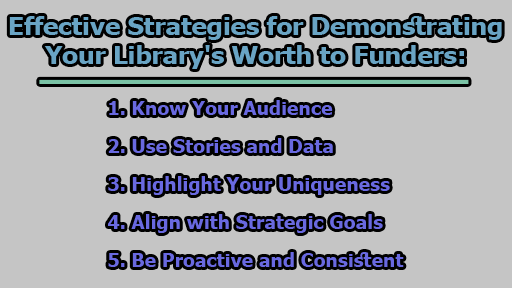Effective Strategies for Demonstrating Your Library’s Worth to Funders:
Public libraries play a pivotal role in our communities, providing access to knowledge, resources, and services that can significantly impact the lives of their patrons. However, libraries often grapple with the challenge of securing adequate funding to sustain their essential operations and programs. To bridge this gap, it’s crucial for libraries to effectively communicate their value to funders and stakeholders. In this article, we’ll explore effective strategies for demonstrating your library’s worth to funders.
1. Know Your Audience: Before crafting your message, it’s imperative to have a deep understanding of your funders and what they care about. Different funders have varying priorities, expectations, and criteria for evaluating a library’s performance and outcomes. Research your potential and existing funders, delve into their goals, interests, and challenges, and tailor your communication to address their specific needs. Show how your library aligns with their mission and vision to demonstrate that your partnership is mutually beneficial.
2. Use Stories and Data: Combining narratives and data is a powerful way to illustrate your library’s value and impact. Stories allow you to capture the human and emotional aspects of your library’s work, demonstrating how you’ve helped patrons overcome challenges, learn new skills, or access vital services. Data, on the other hand, provides concrete evidence of your library’s achievements, such as increased circulation, attendance, or patron satisfaction. By using both stories and data, you can craft a compelling narrative that showcases your library’s relevance, effectiveness, and the tangible benefits it brings to the community.
3. Highlight Your Uniqueness: Your library is more than just a place to borrow books. It serves as a hub of information, education, culture, and innovation. Emphasize the unique programs, services, collections, and partnerships that set your library apart from other organizations and institutions. Clearly explain how your library fills a gap or meets a need that no one else can, and demonstrate how it contributes to the social, economic, and cultural development of your community.
4. Align with Strategic Goals: A library’s value isn’t only measured by what it does but also by how it supports the strategic goals of its funders and stakeholders. Align your communication with the broader objectives and initiatives of your funding sources, whether it’s improving literacy, enhancing digital inclusion, or fostering civic engagement. Show how your library actively contributes to achieving these goals and how it collaborates with other partners and sectors. Illustrate that your library is an integral part of the solution and the vision.
5. Be Proactive and Consistent: Effective communication of your library’s value is an ongoing process that requires proactive and consistent efforts. Don’t wait for funding cycles or crises to reach out to your funders and stakeholders. Keep them informed and engaged throughout the year using various channels and formats, such as newsletters, reports, presentations, social media, or events. Invite them to visit your library, participate in your programs, or provide feedback. Building trust and rapport with your funders and stakeholders will demonstrate that you value their support and input.
In conclusion, in a world where public resources are limited, libraries must be adept at communicating their value to secure funding and support. By knowing your audience, using a combination of stories and data, highlighting your uniqueness, aligning with strategic goals, and being proactive and consistent in your outreach, you can effectively communicate the importance of your library to funders and stakeholders. Your library’s ability to articulate its value persuasively can make all the difference in ensuring it continues to serve as an essential community resource.

Library Lecturer at Nurul Amin Degree College










